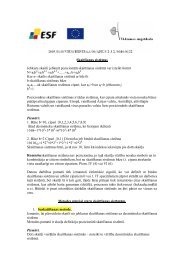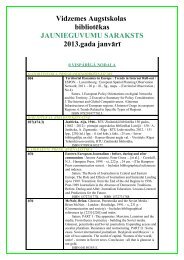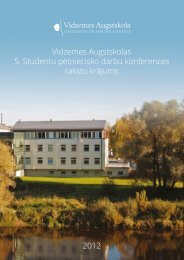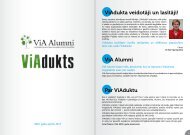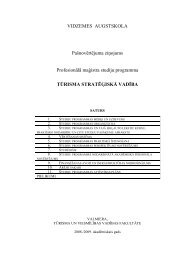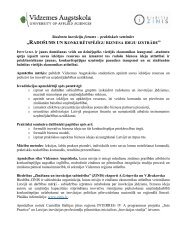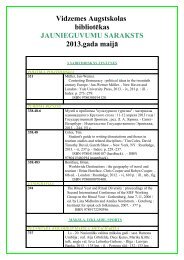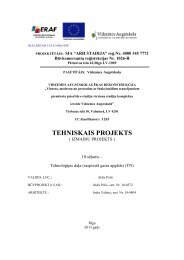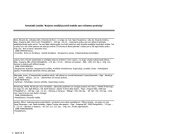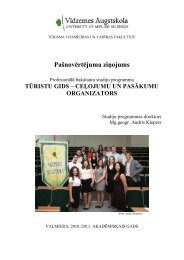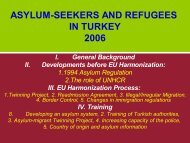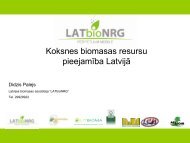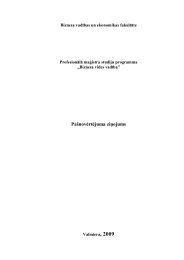Proceedings
Proceedings
Proceedings
You also want an ePaper? Increase the reach of your titles
YUMPU automatically turns print PDFs into web optimized ePapers that Google loves.
Sustainable Planning Instruments and Biodiversity Conservation<br />
Development of Visitor Impact Management in the Heritage Parks: Theoretical Findings<br />
on the number of visitors “how to plan and manage a<br />
particular recreation resource” (Lime, 1976). According<br />
to Bo Shelby and Thomas A. Heberlein’s (1984) decision<br />
on evaluative standards and descriptive information on<br />
relationships between use, management and impacts, it is<br />
a relatively simple matter to define a visitor management<br />
program. Thus, the question revolves around “acceptable<br />
change”. Management methods are approached to define<br />
the objectives. It is an important task to determine which<br />
among the small number of tourism frameworks available<br />
are similar in their characteristics and most suitable<br />
(Table 1). Model Recreation Opportunity Spectrum<br />
(ROS) and Limits of Acceptable Change (LAC), Visitor<br />
Experience and Resource Protection Model (VERP)<br />
(Yosemite National Park) have originated from the<br />
United States, Visitor Activity Management Program<br />
(VAMP) from Forest Tourism and Recreation in Canada,<br />
but the Visitor Impact Management Model (VIMM) is<br />
very similar to the LAC – devised specifically for the US<br />
Parks Service.<br />
Eventually, the Tourism Optimisation Management<br />
Model (TOMM) originated from Australia. It is very<br />
similar to LAC, with a focus on overcoming the lack<br />
of stakeholder support in LAC and VIMM. The terms<br />
‘impact’ and ‘limits’ are perceived as discouraging<br />
growth by tourism businesses, and this model adapts to<br />
tourism needs.<br />
The development of recreation and tourism<br />
frameworks has only occurred in the last 25 years. Such<br />
development generally arose in response to specific<br />
planning and implementation issues (Manning, 2004).<br />
There is a significant body of literature related<br />
to parks and protected area management (Butler &<br />
Waldbrook, 2003; Cole et al, 1997; Manning, 1999;<br />
Manidis, 1997). Recently, the literature has included<br />
visitor impact management which is necessary in parks<br />
and protected areas, like HP. Nowadays heritage parks<br />
are becoming settings for activities that are beyond<br />
recreation: cultural events, after-school activities, job<br />
training, environmental programs, enterprises, volunteer<br />
programs, family picnics, and more.<br />
Recreational activity in HP has become more<br />
prevalent, and many managers have noticed problems<br />
associated with increased visitation. Many of these<br />
problems require complex solutions through regulatory<br />
methods (Payne & Graham, 1993).<br />
According to the opinion of Australian scientists<br />
Michel Hall and Simon McArthur (1998), two main<br />
difficulties in choosing the Visitor Impact Management<br />
Model are: (1) preparation for drafting of a management<br />
plan, and (2) inability to write clear management<br />
objectives.<br />
The author of this article finds two more reasons<br />
which hinder the process: (1) incomplete knowledge<br />
about classical methods of Visitor Impact Management<br />
Models, (2) lack of knowledge on using different<br />
computer software for choosing better alternatives.<br />
To make it easier to choose alternatives, the author<br />
suggests using the software Expert Choice. This<br />
program is devised for using the method of Analytic<br />
Hierarchy Process. The initial version of Expert Choice<br />
was programmed by Ernest Forman from George<br />
Washington University – user-friendly software which<br />
is not so time-consuming (Wasil, 2003).<br />
The answer to the question which is the most<br />
appropriate model for visitor management of heritage<br />
parks is not simple. The following difficulties have been<br />
mentioned by Stephen F. McCool: “Visitor management<br />
framework provides a systematic process so that managers<br />
who are decision makers are fully aware of (1) the desired<br />
future they wish to attain, (2) the alternative routes to the<br />
future, and (3) the consequences of those alternatives”<br />
(McCool, 2005, p. 4).<br />
The choice of alternative visitor management models<br />
for the HP is a future task of the NVBR. It has been<br />
scheduled to renew the Braslava HP near Mazsalaca<br />
in the NVBR within the United Nations Development<br />
Programme (UNDP) and Global Environmental Facility<br />
(GEF) project “Biodiversity Protection in the North<br />
Vidzeme Biosphere Reserve.”<br />
Heritage parks are intended to “provide a foundation<br />
for spiritual, scientific, educational, recreational and visitor<br />
opportunities, all of which must be environmentally and<br />
culturally compatible.” (WCMC, 2004)<br />
4 Results and Discussion<br />
After examining several parks in Canada, Switzerland,<br />
Australia, the United States and the United Kingdom<br />
in comparison with NVBR in Latvia, the author<br />
established that in these countries HP have: (1) larger<br />
areas; (2) predominance of public properties; (3) larger<br />
HP activity commercialization. However, in the NVBR,<br />
heritage parks have: (1) smaller areas; (2) different forms<br />
of property; (3) each place has specific conditions which<br />
require individual planning and management solutions<br />
for each HP in the NVBR.<br />
An analysis of the study data showed differences<br />
among the HP, which indicated a necessity to choose the<br />
most appropriate management model for each particular<br />
NVBR heritage park.<br />
As a result of this study, the author distinguished three<br />
possible Visitor Management Models: VIMM, VAMP<br />
and TOMM, which were used in further research. The<br />
processing of response data from the research involving<br />
three experts showed that (1) through the application of<br />
three main criteria, the highest ranked was the level of<br />
sustainable tourism followed by the level of application<br />
by management and the level of visitor friendliness. In<br />
the case if the data consistency ratio (CR) = 0.1 or more,<br />
for example, for TOMM with the advantage of 35.7%,<br />
inconsistency and lack of uniformity among the criteria<br />
occur. However, if the value of the consistency ratio is<br />
smaller or equal to 10%, the inconsistency is acceptable.<br />
If the consistency ratio is greater than 10%, the subjective<br />
judgment needs to be revised. Synthesis with respect<br />
to the level of sustainability gave preference to VAMP<br />
by 39.9% and CR = 0.02. Synthesis with respect to the<br />
level of application by management gave preference to<br />
TOMM by 36.6% and CR = 0.01. Synthesis with respect<br />
to the level of visitor friendliness with consistency ratio<br />
(CR) = 0.1 gave preference to TOMM by 37.7%. Synthesis<br />
with respect to the goal: best model with CR = 0.1 gave<br />
preference to TOMM by 35.7%, VIMM was in the third<br />
place – 29.5%.<br />
5 Conclusions and Recommendations<br />
As a result of the research, the author draws the<br />
conclusion that, considering three alternatives – TOMM,<br />
VIMM and VAMP – with the three criteria of the level<br />
of sustainability, the level of application by management<br />
and the level of visitor friendliness, the TOMM<br />
alternative was given significant preference over other<br />
alternatives, especially over VIMM. That means that it<br />
is necessary to continue the research while expanding<br />
the areas of research criteria. While performing the task<br />
of the research, the author met an insufficient number<br />
of experts in the sphere of Visitor Impact Management<br />
Models because of the lack of knowledge on classical<br />
methodical questions on visitor impact management.<br />
The author concedes that the reason could be the lack of<br />
education and language barriers. The author recommends<br />
NVBR specialists to turn their attention to the choice of<br />
a HP Visitor Impact Management Model and to improve<br />
their knowledge in this particular field. Finally, different<br />
methods and tools would allow heritage park managers<br />
to have better insight into how the tourism industry<br />
operates, which should make it possible for them to<br />
minimize the impact of visitors on the heritage parks in<br />
the NVBR through making use of the knowledge on the<br />
HP Visitor Impact Management Model as a sustainable<br />
planning instrument.<br />
Acknowledgements<br />
The author would like to thank Iluta Bērziņa, Jānis<br />
Sirlaks and Aleksandrs Raubiško for their participation<br />
and contribution to this research.<br />
References<br />
About.com. US & Canadian Parks: National Parks – The<br />
Classification System Designation of National Park<br />
System Units. http://usparks.about.com/gi/dynamic/offsite.htm?site=http://www.nps.gov/legacy/nomenclature.<br />
html.<br />
Answers.com. 2009. Public Health Encyclopedia Dictionary –<br />
carrying-capacity. http://www.answers.com/topic/carrying-capacity.<br />
The Australian Government, Department of the Environment,<br />
Water, Heritage and the Arts. Australia's Heritage. http://<br />
www.environment.gov.au/heritage/index.html.<br />
Bouma, J., Brouwer, R., van Ek, R. 2000. The Use of Integrated<br />
Assessment Methods in Dutch Water Management: a<br />
Comparison of Cost-Benefit and Multi-Criteria Analysis.<br />
In: Third International Conference of the European<br />
Society for Ecological Economics, Vienna, 3–28, 18–25.<br />
Butler, R. W. and Boyd, S. W. 1996. Managing Ecotourism: An<br />
Opportunity Spectrum Approach. Tourism Management<br />
17(8), 557–566.<br />
Butler, R. and Waldbrook, L. 2003. A New Planning Tool:<br />
The Tourism Opportunity Spectrum. Journal of Tourism<br />
Studies 1: 25–36.<br />
Cole, D. N., Stankey, G. H. 1997. Historical Development of<br />
Limits of Acceptable Change: Conceptual Clarifications<br />
and Possible Extensions. United States Department of<br />
Agriculture Forest Service, General Technical Report,<br />
Issue 371. P. 5–9. http://direct.bl.uk/bld/PlaceOrder.do?U<br />
IN=042810071&ETOC=RN&from=searchengine.<br />
Dictionary.com. 2009. Dictionary – carrying capacity. http://<br />
dictionary.reference.com/browse/carrying%20capacity.<br />
Eagles, Paul F. J., Stephen McCool and Christopher<br />
Haynes. 2002. Sustainable Tourism in Protected Areas:<br />
Guidelines for Planning and Management. United Nations<br />
Environment Programme, World Tourism Organization,<br />
and World Conservation Union.<br />
Hall, C. M. and McArthur, S. 1998. Heritage Management<br />
in New Zealand and Australia: Visitor Management,<br />
Interpretation, and Marketing. Auckland: Oxford<br />
University Press.<br />
Lime, D. W. 1976. Principles of Recreational Carrying<br />
Capacity. In: <strong>Proceedings</strong> of Southern States Recreation<br />
Research Applications Workshop. General Technical<br />
Report SE-9. U.S. Department of Agriculture, South-<br />
Eastern Forest Experiment Station, Asheville, NC:<br />
122–134.<br />
Manning, R. E., Valliere, W. A. and Wang, B. 1999. Crowding<br />
Norms: Alternative Measurement Approaches. Leisure<br />
Sciences 21 (2): 97–115.<br />
Manning, R. E. 2004. Recreation Planning Frameworks.<br />
Society and Natural Resources: A Summary of Knowledge<br />
(eds. Manfredo, M. J. et al). Jefferson. P. 83–96.<br />
Manidis, R. 1997. Developing a Tourism Optimisation<br />
Management Model (TOMM). A model to monitor and<br />
manage tourism on Kangaroo Island. Final Report, South<br />
Australian Tourism Commission, Adelaide. http://tourism.<br />
sa.gov.au/tourism/publications.asp.<br />
McCool. S. 2005. Outdoor Recreation in the New<br />
Century: Frameworks for Working Through the<br />
Challenges. Presentation at the 2005 Society of<br />
American Foresters National Convention, October<br />
19–23, Ft. Worth, TX. P. 4. http://www.cfc.umt.edu/<br />
personnel/.smccool/Recent%20Publications_ files/<br />
McCool%20SAF%20paper.pdf.<br />
Parks of the World. 2008a. International Park System. http://<br />
parksoftheworld.org/worldparks.html<br />
Parks of the World. 2008b. "The World is a Park with Countries<br />
in It.” http://parksoftheworld.org/planearth.html<br />
32<br />
33



